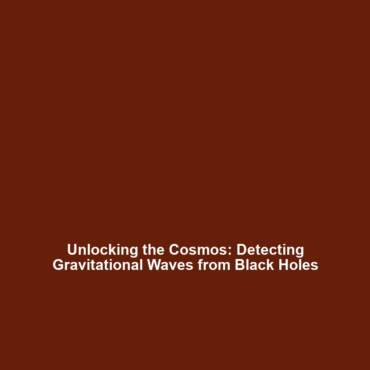How Space-Based Detection Can Observe Lower-Frequency Waves from Supermassive Black Hole Mergers
Introduction
Gravitational waves, ripples in spacetime caused by massive cosmic events, have revolutionized our understanding of the universe. Among these phenomena, the merger of supermassive black holes produces lower-frequency gravitational waves that existing ground-based detectors struggle to observe. This article explores how space-based detection, such as the Laser Interferometer Space Antenna (LISA), can successfully capture these elusive signals and enhance our comprehension of gravitational waves, paving the way for unprecedented astrophysical insights.
Key Concepts
Understanding Gravitational Waves
Gravitational waves are generated by the acceleration of massive objects, particularly during extreme astrophysical events like black hole mergers. The frequency of these waves depends on the masses and velocities of the sources. For supermassive black holes—those with masses millions to billions times that of our Sun—mergers occur at frequencies too low for ground-based detectors such as LIGO and Virgo.
The Role of Space-Based Detection
Space-based detectors offer a unique advantage in observing lower-frequency waves. These observatories operate above the atmosphere, free from terrestrial noise, allowing for the detection of signals in several milliHertz (mHz) ranges. The planned LISA mission will utilize laser interferometry to measure minute changes in distance caused by passing gravitational waves, thus enabling the observation of supermassive black hole mergers.
Applications and Real-World Uses
Space-based detection technologies are poised to transform our understanding of the cosmos. Some key applications include:
- Cosmology: By observing the frequency and characteristics of gravitational waves, scientists can infer details about the early universe and the formation of large-scale structures.
- Black Hole Studies: Understanding the dynamics and frequency of supermassive black hole mergers could catalyze developments in theories of gravity and quantum mechanics.
- Astrophysical Probes: Lower-frequency waves can provide insights into the distribution of dark matter and insights into exotic objects like neutron stars.
Current Challenges
Despite promising developments, the field faces several challenges:
- Technological Limitations: Developing sensitive instrumentation capable of detecting low-frequency waves remains a technical hurdle.
- Funding and Support: Expensive missions such as LISA require significant investment and international collaboration.
- Data Analysis: Processing and interpreting the vast amounts of data generated poses a logistical challenge.
Future Research and Innovations
The future of detecting lower-frequency gravitational waves holds exciting potential. Innovations may include:
- Advanced Detectors: Next-generation technologies improving sensitivity and range, critical for observing black hole mergers.
- International Collaborations: Partnerships between space agencies might yield more comprehensive data.
- Machine Learning Techniques: Enhancing data analysis through artificial intelligence could streamline the identification and classification of signals.
Conclusion
The study of lower-frequency gravitational waves from supermassive black hole mergers through space-based detection is an emerging frontier in astrophysics. These investigations not only deepen our understanding of fundamental cosmic processes but could also unveil the mysteries of dark matter and the evolution of the universe. As research progresses and new technologies emerge, we invite readers to stay informed about developments in gravitational waves and related cosmic phenomena. For more details, consider exploring topics such as observing black holes and the future of gravitational waves.

Leave a Reply